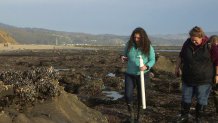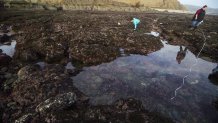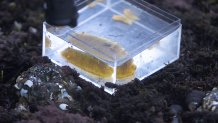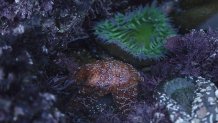The legendary surfing spot known as Mavericks near Half Moon Bay attracts surfers and onlookers to its super dramatic skyscraper-like waves. But when researchers Alison Young and Rebecca Johnson of the Cal Academy of Sciences visit the spot every month, it’s purposely on a day when there are no waves.
For the last eight years, the pair have lead a scientific effort to catalog all the sea creatures that make their home in the moonscape-like reef, which is only revealed during low tides.
“We’re just searching and seeing what we can find and seeing what we can count,” Johnson said, standing in a spot that would normally be underwater. “So we can look at change through time.”

On a recent low tide, the pair stepped out onto the vast reef, peering into each tide pool and crevice for any signs of life. At a specific point, they took a roll of measuring tape and marked out six rectangular plots which make up a recurring study area. A cheer went up at the first find of the day — a tiny ivory colored nudibranch — or sea slug. Another cry rang out at the sighting of a black turban snail, sitting not far from a brown turban snail. Young jotted the observations into a notebook.
“Personally i love the tide pools,” Young said. “I love this interface between land and ocean.”
Johnson excitedly pointed out the prize find of the day, a gumboot chiton — a mollusk that resembled a small football. She snapped a photo with her phone. She also noted colorful sea urchins, scurrying hermit crabs, and a floating piece of sea nettle.
“One of the things for me that’s most fun,” Johnson said, “is just to find a little spot and sit still and then you can see like fifty different species right in front of you.”

The area the scientists are monitoring is just a stone’s throw from the Fitzgerald Marine Reserve, which sits just North of Mavericks. That site has undergone continual study by biologists who have well-documented its sea creatures. But Young said Maverick’s has not been subject to a formal study to catalog its marine life. So twice a month the women return to the reef to add more observations to their running catalog.
Local
“We’ve been working at building a species list for about eight years,” Young said, “and have about 650 species that we’ve seen at one point or another.”
The study has also documented the impact of sea star wasting disease, a virus that has killed millions of starfish across forty different species. On the side of a large half-submerged rock, Johnson pointed out a cluster of starfish that appeared limp, the telltale signs of the wasting disease.
Johnson took a picture of the scene which she uploaded to the app INaturalist, a citizen-based scientific community that helps identify and map species of wildlife. Johnson said she’ll often turn to the online community to help ID unknown creatures.

But the researcher’s usage of a citizen scientists isn’t just limited to the virtual world. The pair routinely bring out volunteers to help with the observation and tally, sometimes hosting as many as twenty volunteers to help look for creatures.
Johnson said one of the main goals of the volunteer project, which is open to anyone is “to build a community of naturalist and folks that know about this place and care about it.”
On a recent expedition, volunteer Katie Bertsche enthusiastically searched for sea slugs amid the roiling tide pools that pockmarked the reef.
“It’s just a wonderful way to sort of get out and enjoy nature,” Bertsche said, “but also contribute to knowledge and science.”
Adding to the mystique of the tide pools is the fact they are only visible on occasion — mostly covered by the churning waters that have made Mavericks a top world destination for surfing. The tides offer only a small window to experience the reef.

“Especially people who’ve been out here to watch the waves,” said Young, “and they come out here at low tide and they have no idea this is here.”
Even as the sun began to set, filling the sky with a deep orange as if it had been painted in long brush strokes, the scientific gathering continued — only with a little more fun bent. Young cast a hand-held ultra-violet light into the tide pools, causing some sea anemone and starfish to glow a fluorescent color.
As the tide began to slowly retake the reef — restoring the beach’s pedigreed waves — the scientists finally decided to call it a day, maneuvering across the tide pools as the orange sky turned to night and the sound of waves grew louder.



